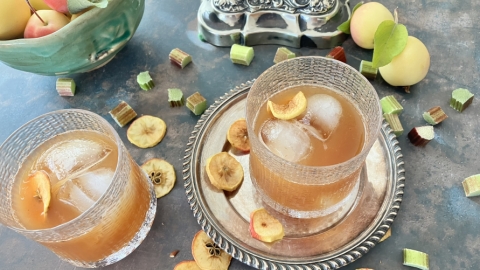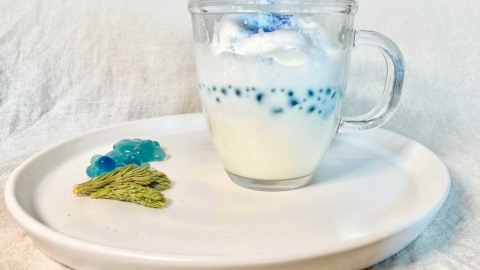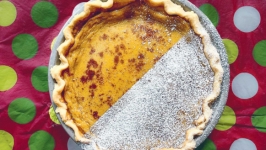Creative Juices
At this time of year, mind and spirit turn towards gatherings. The holidays are coming—you can smell it in the cold mornings, and see it on the afternoon walk home, when the sun slants through bare branches, casting blue shadows.
For home cooks, there’s a special delight in the planning and preparation of jams, jellies, cookies, and cakes, in the putting-together of boxes and tins of goodies to share around the neighborhood. Those in charge of hosting stay up late, creating cocktails in their head, imagining fun non-alcoholic beverages, thinking about combinations of berries, herbs, even apples.
I never thought that my northern life would include growing apples. But it does. Some years ago, inspired by a neighbor who discovered a crabapple tree in the backyard of her new house, my husband and I purchased two apple trees from John Lenart of Klondike Valley Nursery. John is an adventurer in growing circles; he has worked for years with various university agricultural programs to produce cold-hardy trees and fruits for northern gardeners. He operates out of his homestead, a tall wooden house surrounded by apple trees, greenhouses, and rows of vegetable gardens, nestled on an island in the Klondike River a few kilometers south of Dawson.
It takes four canoe rides get to his island and then transport the trees back to your car—one ride to the small island between the shore and his place, a short walk to the next canoe, another ride to his island, and then back again. The canoes are red, or at least they were in 2013. It’s an enchanting way to start your apple trees’ journey home. (Also enchanting is to visit the market in Dawson on a Saturday morning. John is often there with his trees, fruits, and vegetables.)
We planted our trees against a sunny, west-facing wall, built a barrier against the south wind that howls down our street, and waited. It took four years for the trees to produce fruit. Our first harvest was a lone apple from each tree. We turned each one in our hands, marvelled, took pictures, congratulated ourselves, and crunched, sharing bites, exclaiming over the flavor.
Both our trees are cold hardy apple-crab hybrids, one a Norland, the other a Trailman. The harvest has since grown to about 25 pounds annually from both trees combined, mostly golf ball sized. (They are apple-crabs, after all.) We’ve found the Norlands are great for eating or juice, the Trailmans best for juice or jelly, though after the first frost the Trailmans have a wonderful balance of tart and sweet.
Once the harvest grew, to help with juice-making, we bought a Finnish steam juicer known as the Mehuliisa, which eliminates the need to strain out the pulp, and produces a clear, bright juice, whatever the fruit. Indeed, we now use the Mehuliisa to juice apples, rhubarb, and highbush cranberries, and regularly lend it out to friends for their harvests. We typically store the juice in resealable bags in the freezer, ready to turn into jelly, but also to defrost and enjoy as is. There’s nothing like a glass of rhubarb or apple juice in the middle of February.
There are more accessible methods for making juices, and drinks too, that don’t require special equipment. We can blend raw berries with water, strain, and add sweetener. Cook fruits in water and strain. Or we can make syrups.
Syrups last for a long time in the fridge and slide into cocktails or non-alcoholic drinks easily, opening up a world of flavors hitherto not imagined—spruce tip syrup, birch syrup, of course, but also rhubarb, berry, or wild pineapple weed.
The wild and garden stalwarts in our neck of the woods, the ones we can rely on to show up every year, are rhubarb, lamb’s quarters, pineapple weed, and apples. For this holiday season, I’ve focused on three of the four, leaving the lamb’s quarters for another time (though if you have any frozen, they’re great in the morning smoothie).
Make Miche's juicy beverages:
Chamomile Old Fashioned
One Good Apple Cocktail
Rhubarb & Chamomile Soda
Rhubarb French 75


















